The Tony & Libba Rane Culinary Science Center (RCSC) brings all components of hospitality management education together under one roof at Auburn University in Auburn, Ala.
A lead gift from the Rane family in 2017 helped launch the project and led to the center’s naming in honor of the parents of Jimmy Rane, a 1968 alumnus who was the first in his family to earn a college degree and is a member of the Auburn Board of Trustees.
The vision for a unique culinary science center at Auburn traces back some 20 years with multiple people at the table, including academic and hospitality industry leaders. Leaders at Auburn University’s College of Human Sciences dreamed of and established the vision in collaboration with industry leaders such as Horst Schulze, co-founder and former president of Ritz-Carlton Hotel Company, and Hans van der Reijden, founder and CEO of Ithaka Hospitality Partners.
“I made many trips with a team of leaders to globally recognized hospitality management programs and facilities around the world, including South Africa, Europe, Singapore, Australia and the United States, to discover what existed and what was needed,” says Dr. Martin O’Neill, head of the Horst Schulze School of Hospitality Management at Auburn University. “We discovered that many programs and facilities had a teaching restaurant or an association with a management company that manages a hotel, but none had it all. We wanted a state-of-the-art, stand-alone education building that brings everything together and is designed to teach students in real-world scenarios.”
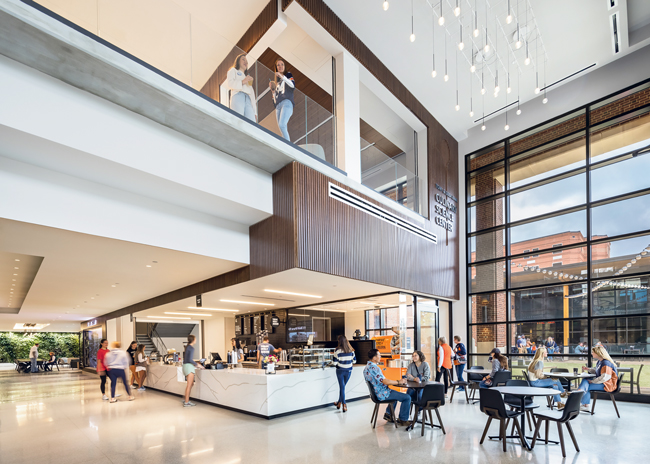 Photos by Jonathan Hillyer Photography Inc.
Photos by Jonathan Hillyer Photography Inc.
Also taking many of these trips was van der Reijden, whose company oversees the commercial/retail foodservice facets of the center, as well as the Hotel at Auburn University and Dixon Conference Center, which is adjacent to the Rane Center. The university oversees the academics and culinary labs. “We wanted to go beyond what currently exists in hospitality management education,” van der Reijden says. He has a close alliance with Horst Schulze, having worked as an executive in The Ritz-Carlton Company for 11 years before becoming a partner in Capella Hotel Group.
After the decision was made to move ahead with a center, Cooper Carry architects in Atlanta joined the project team. “The mission of Auburn University with this project is to put practical knowledge into the hands of those who can use it, create economic opportunities and improve the quality of our lives,” says Brian Campa, AIA, LEED AP, principal. “The mission also was to shine a light on Auburn and Alabama as an incubator of world-class hospitality talent, to seamlessly blend the academic/hospitality spaces, create an environment that is both educational and memorable for patrons, and provide world-class, hands-on learning to students in the culinary and hospitality industries.”
The architects brought in Colorado-based Ricca Design Studios’ Phillip Landgraf, FCSI, executive principal, and Garret Sletten, project director, as foodservice design consultants on the project. “Having multiple parties involved in the design of this facility allowed for a wide range of stakeholders and expert input,” Landgraf says. “Each of the elements within the RCSC is geared toward educating future hospitality leaders as well as providing amazing service to the Auburn community. The ultramodern elements in the RCSC creates one of the most immersive and unique learning environments the state and even the country has ever seen.”
Architects and foodservice design consultants were challenged to build a facility that symbolizes innovation yet remains contextual to Auburn’s architectural image and character. Another challenge for architects was ensuring that unique specialty equipment, utilities and systems support the building’s functions. “Space utilization studies were carried out to evaluate the use of each room based on the academic schedule,” Campa says. “In addition, each space was designed to convert from specialty use, like wine appreciation, to general classroom presentations. We had to ensure that specialty classrooms function well but can also be used for general academics.”
Another complex design challenge involved designing a rooftop garden and pool over a five-diamond hotel/spa, classrooms, culinary labs, teaching restaurants and a cafe. “Complex coordination exercises facilitated the overlapping systems, structure and support for each building level,” Campa says.
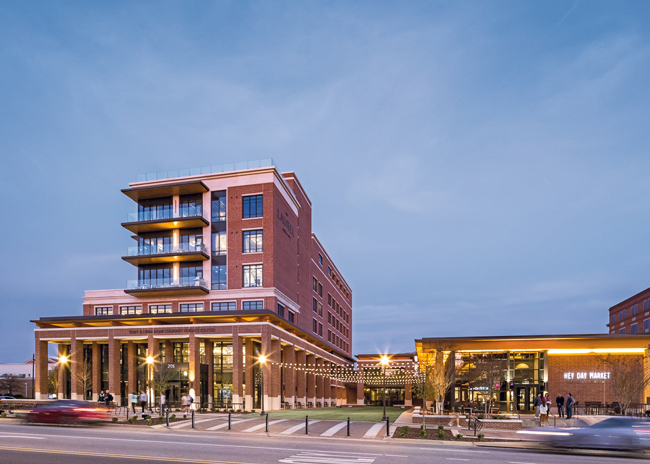 Hey Day Market sits next to the Tony & Libba Rane Culinary Science Center at Auburn University, Auburn, Ala.
Hey Day Market sits next to the Tony & Libba Rane Culinary Science Center at Auburn University, Auburn, Ala.
Designated Spaces
Because the university and Ithaka Hospitality are involved in the center, a commercial laundry center does the laundry for The Laurel Hotel & Spa, as well as The Hotel at Auburn University. Both stakeholders receive food and goods via the main loading dock, which was a requirement to make this building work. Food delivery, laundry (both soiled and clean) going in and out, and any other delivery comes through the main dock, which sits in the lower sub-grade level of the Rane Center.
“To keep products and goods separate, so that one team doesn’t get food intended for another team, and to keep inventory and tracking separate, the dock and lower-level space has walk-in coolers for meat, vegetables and dairy, a walk-in freezer and dry storage,” Landgraf says. The food hall’s third-party vendors use designated cages that they can lock. A separate walk-in holds vegetables that need washing before they get distributed to the culinary labs or are stored for future use.
The 1856 – Culinary Residence, culinary laboratories, New Realm Brewing Co. and Hey Day Market have designated walk-ins in their spaces, as well, on the level where the loading dock resides. “This was a need, based on how many different classes, stakeholders and parties need refrigerated storage, and need to have inventory kept separate,” Landgraf says.
Warewashing varies among the operations. For example, warewashing is self-contained per platform in in Hey Day Market, which is a food hall. For the culinary labs, however, the warewashing rooms are situated as pass-through rooms in between the labs. “This increased efficiency with equipment and expenses for warewashing,” Landgraf says. “Also, having them tucked away means that these aren’t as public to the interior of the building, but they still maintain some exterior windows touching back to
not hiding as much and keeping operations transparent.”
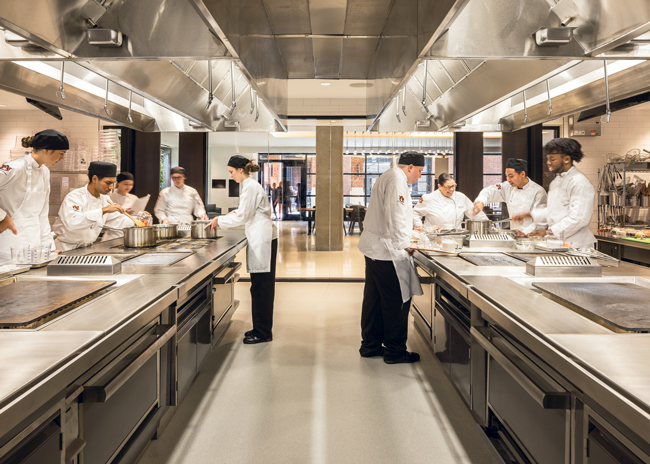 Culinary Laboratory 1 contains two 20-quart mixers, two food processors, two blenders, two slicers, an induction cooker and a vacuum packing machine. A combi oven sits at the end of one of the dual cooking suites. Each cooking suite contains a six-burner range along with a chargrill, dual fryers, a flattop griddle, a plancha and a pasta cooker.
Culinary Laboratory 1 contains two 20-quart mixers, two food processors, two blenders, two slicers, an induction cooker and a vacuum packing machine. A combi oven sits at the end of one of the dual cooking suites. Each cooking suite contains a six-burner range along with a chargrill, dual fryers, a flattop griddle, a plancha and a pasta cooker.
1856 – Culinary Residence
1856 – Culinary Residence, a teaching restaurant, serves a la carte lunch and a tasting menu for dinner. The restaurant’s front- and back-of-the-house functions are conducted mainly by the culinary program’s junior- and senior-level students under supervision and instruction of professional chefs and chef instructors. “Because 1856 – Culinary Residence is located in a prominent corner of campus, we wanted to make sure that the restaurant was a beacon for the university,” Campa says. “Showcasing the kitchen also allows for showcasing the chef-in-residence, who changes from time to time.”
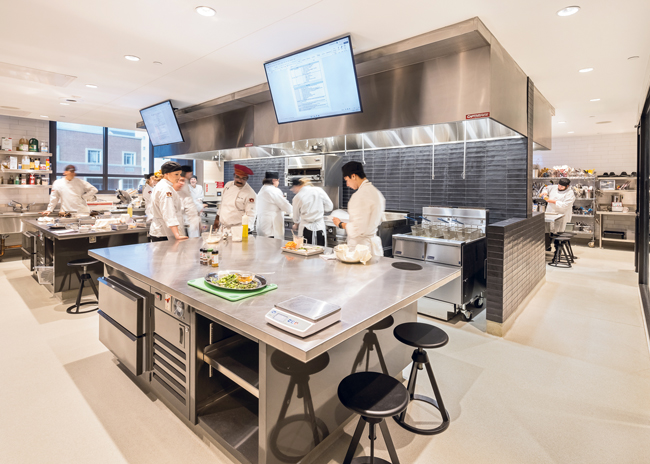 The pastry laboratory contains a 20-quart and a 40-quart mixer, a 20-quart tilting kettle, a two-burner range, a double hydrovection oven, a rotating rack oven, a proofer/retarder, a blast chiller, roll-in freezer and roll-in refrigerator and induction cooker.The space highlights the open kitchen and gives guests — up to 48 at nine tables — a VIP-type experience while they watch the culinary action. Several exterior windows line the kitchen from the street level and several windows face campus. The large open kitchen contains a central cooking suite to emphasize the transparency of kitchen operations and training. This was intended to give upperclassmen a feeling of pressure to deliver a high level of culinary service, Landgraf says, which they will find in the industry outside of school.
The pastry laboratory contains a 20-quart and a 40-quart mixer, a 20-quart tilting kettle, a two-burner range, a double hydrovection oven, a rotating rack oven, a proofer/retarder, a blast chiller, roll-in freezer and roll-in refrigerator and induction cooker.The space highlights the open kitchen and gives guests — up to 48 at nine tables — a VIP-type experience while they watch the culinary action. Several exterior windows line the kitchen from the street level and several windows face campus. The large open kitchen contains a central cooking suite to emphasize the transparency of kitchen operations and training. This was intended to give upperclassmen a feeling of pressure to deliver a high level of culinary service, Landgraf says, which they will find in the industry outside of school.
“We wanted the kitchen to have a European design so the cooks face each other as they work, cooking is centralized and menu items move toward the chef for final preparation and inspection before being served to guests,” says chef Leonardo Maurelli III, managing partner, culinary operations for Ithaka Hospitality Partners. “The menus rotate often to give students experience preparing many different menu items.”
Food and supplies arrive on the lower level of the center. Staff bring them up to 1856 – Culinary Residence and place them into a walk-in cooler, a walk-in freezer and dry storage. Each foodservice area’s staff requestions what it needs for the day, and staff deliver it to the areas.
On the suite, student staff prepare steak haché, 1856 Culinary Residence [dry-aged] Burger, fish for the fish and chips plate on the chargrill, and l’entrecote (rib-eye steak) with pomme puree (mashed potatoes) and bone marrow jus on a yakitori grill. “We brought this in as an extra to the equipment package because it gives a different finish to the grilled menu items,” Maurelli says.
Staff use the plancha to prepare chicken schnitzel, steak, snowy grouper and queen snapper. They prepare vegetable and accoutrements for grilled menu items and keep sauces warm on the six-burner range. The fryers cook fries and menu items such as crispy flounder. The salamander heats menu items to finish them and melts bone marrow. The pasta cooker exclusively cooks pasta that can be served as is or finished in a saute pan.
Maurelli notes that a combi oven was added specificially for the equipment’s versatility to cook meats, vegetables, desserts and pastries.
Each year, 1856 hires a resident chef to bring in a unique culinary perspective. This year’s chef is Ford Fry, owner of many restaurants, including King + Duke in Atlanta and The Optimist and Le Loup in Nashville and State of Grace and La Lucha in Houston. “My hope is that students will gain an understanding of seasonality and the importance of working with what the farmers are growing versus sourcing ingredients based on what they want to cook,” Fry says.
Fry and his team members introduce favorite menu items from their Atlanta restaurants, such as Marcel’s decadent buttery bread. He emphasizes proper cooking technique when teaching students. “The Auburn facilities offer all the different pieces of modern equipment you’d need to achieve that proper technique, so we utilize those resources to lay out the stations very specifically and with a dedicated staff member side by side with each student to ensure a calm learning environment,” he says.
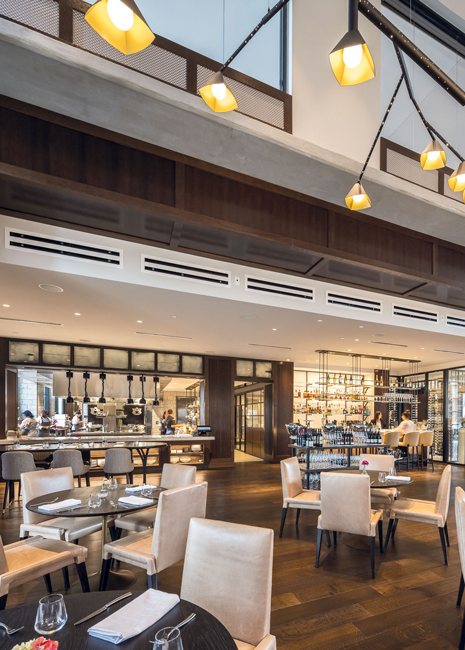 1856 – Culinary Residence, a teaching restaurant, serves as a beacon for the university. It serves an a la carte lunch and a tasting menu for dinner.
1856 – Culinary Residence, a teaching restaurant, serves as a beacon for the university. It serves an a la carte lunch and a tasting menu for dinner.
Culinary Laboratories
Keeping with the transparency theme, the culinary laboratories are not hidden away from sight, but are instead located in front of students, staff and guests. All culinary labs on level one contain large glass exterior windows and full glass interior walls that highlight the teaching taking place in the spaces. This allows future students to walk through the space and see the bustle of the classes, while not interrupting the students in class. It also allows guests to experience a full kitchen operation.
Level two also allows for such transparency with the wine appreciation and distilled spirits laboratories and refrigerated storage rooms on full display. The coffee cafe on level one was also designed with transparency in mind; it features a full glass room where roasting takes place.
Culinary Laboratory 1 contains two 20-quart mixers, two food processors, two blenders, two slicers, an induction cooker and vacuum packing machine. Students cook facing each other on one of the two double-sided custom cooking suites. A combi oven sits at the end of one of the dual cooking suites, each of which contains a six-burner range, a chargrill, a flattop griddle, a plancha, dual fryers and a pasta cooker.
Culinary Laboratory 2 contains similar equipment with the exception of a cooking suite. Rather, the hot cooking equipment sits in a line along one wall. This lab also has a blast chiller, tilting skillet, wok range and steam-jacketed kettle.
The laboratory designated for pastries contains a 20-quart and a 40-quart mixer, a 20-quart tilting kettle, a two-burner range, a double hydrovection oven, a rotating rack oven, a proofer/retarder, a blast chiller, roll-in freezer and roll in refrigerator and induction cooker.
Crossover Learning
Students staff the Laurel Hotel & Spa as part of their learning experience. The design of the hotel was inspired by the warm colors of spices, which influenced the kaleidoscope-style digital artwork found throughout the spaces. The name “Laurel” both stands for an edible bay leaf and is symbolic of academia with many universities still handing out laurel wreaths at graduation ceremonies.
For the hotel operation, this kitchen contains a full cookline, refrigerated storage and its own self-contained warewash area so staff can provide small plate and menu items to the hotel guests only. This kitchen also supports event catering for the rooftop area. The rooftop has a fully stocked and self-supported bar for service to the pool on the roof, and a secondary bar to support any event taking place on the roof.
Walt & Ginger Woltosz Rooftop Terrace & Gardens is available for hotel guests and guests of the spa. It has a green-roof aspect to facilitate a partnership with the College of Agriculture for using compost waste from the kitchen and allowing the Horticulture Program faculty and students to grow produce and plants for use in 1856 – Culinary Residence and the culinary laboratories.
This grand endeavor in hospitality management education will undoubtedly receive attention in coming years. The project is on track to achieve LEED Silver certification.
“What’s extraordinary is walking into an energetic building where you feel the enthusiasm of partners, faculty and students,” O’Neill says.
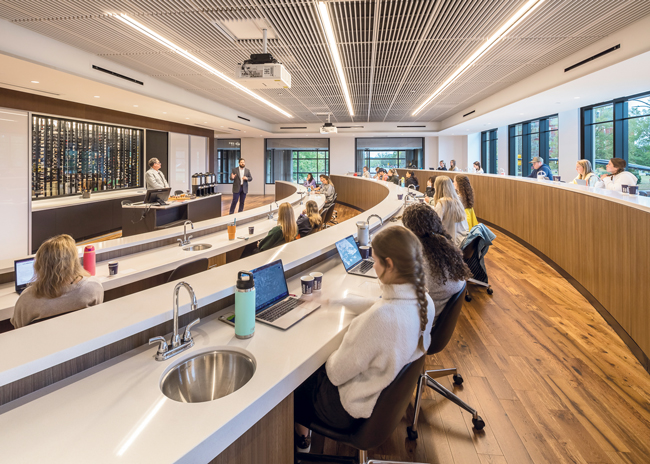 The wine and distilled spirits classroom sits above 1856 – Culinary Residence.
The wine and distilled spirits classroom sits above 1856 – Culinary Residence.
About the Project
Opened: Summer 2022
Scope of project: A project for the Horst Schulze School of Hospitality Management that includes an academic office space, classrooms, laboratories and multiple commercial offerings
Equipment investment: $3.4 million
Website: ranecenter.auburn.edu
Size: 142,000 sq. ft.; 6-story complex
1856 – Culinary Residence: 3,800 sq. ft.
Culinary labs and pastry laboratories: 5,800 sq. ft.
Wine tasting and distilled spirits laboratories: 12,500 sq. ft.
Hey Day Market: 6,900 sq. ft.
Seats:
- 1856 – Culinary Residence: 48 seats with 9 tables, plus a 14-person private dining room
- Hey Day Market: 108 indoors and 36 outdoors
- New Realm Brewing Co.: 13 seats (25 max. occupancy)
Hours: 1856 – Culinary Residence: Tuesday through Saturday, lunch, 11 a.m. until 2 p.m., and dinner, 5:30 p.m. until 9:00 p.m.
Average check:
- 1856 – Culinary Residence: $110 for tasting menu; wine pairing $90 additional
- Staff: 300 in 3 buildings, including 25 for 1856 – Culinary Residence
- Total project cost: $110 million
Key Players
- Owner: Auburn University
- Dean, College of Human Sciences: Susan Hubbard, Ed.D.
- Department head, Horst Schulze School of Hospitality Management: Martin O’Neill, Ph.D.
- Commercial operations: Ithaka Hospitality Partners
- CEO: Hans van der Reijden
- Managing partner, room & spa operations: Paul Reggio
- Managing partner: Adam Keeshan
- Managing partner, culinary operations: Leonardo Maurelli III
- Chef de cuisine, 1856 – Culinary Residence: Thomas Baco-Wang
- Chef in residence, 1856 – Culinary Residence: Ford Fry
- General manager, The Laurel Hotel: Josh Head
- Spa director, The Laurel Hotel: Chandra Perry
- Executive chef: Amanda Trawick
- Mentor and advisor: Horst Schulze, co-founder of The Ritz-Carlton Hotel Company, School of Hospitality Management benefactor, and Ithaka Hospitality Partners executive advisor
- Architect: Cooper Carry, Atlanta; Brian Campa, AIA, LEED AP, principal; Chrissy Perez, NCARB, LEED AP, project manager
- Interior design: The Johnson Studio, a division of Cooper Carry, Atlanta
- Foodservice consultants: Ricca Design Studios, Greenwood Village, Colo.: Phillip Landgraf, FCSI, executive principal; Garret Sletten, project director
- Culinary consultant: Lawrence McFadden, CMC, ECM
- Equipment dealer: Mobile Fixture & Equipment Co., Mobile, Ala.
- Construction: Bailey-Harris Construction Co., Auburn, Ala.




